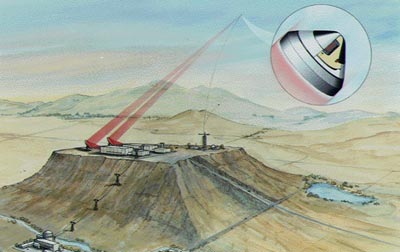Envoyer les déchets dans l’espace permet de les isoler complètement de la biosphère. Il s’agit néanmoins d’une méthode exotique, qui ne peut être envisagée qu’au cas par cas. Or l’énergie nucléaire a ceci de particulier qu’elle produit de très petites quantités de déchets très toxiques, ce qui fait de l’élimination spatiale une option viable.
- Nasa Technical Paper N°1225: Nuclear Waste Disposal in Space, R. E. Burns, W. E. Causey, W. E. Galloway, and-R. W. Nelson, May 1978.
“The practicality of disposal of nuclear waste in space depends very strongly upon how much nuclear waste will be generated. Although space offers complete isolation of waste from the biosphere, it is a rather exotic method of disposal and could not be considered for many toxic substances (such as industrial wastes). Nuclear power is a unique industrial process in that it produces very small amounts of very toxic waste. This combination makes space disposal a viable option.” https://ntrs.nasa.gov/archive/nasa/casi.ntrs.nasa.gov/19780015628.pdf
2. Mars 1980: ANALYSIS OF NUCLEAR WASTE DISPOSAL IN SPACE–PHASE III https://ntrs.nasa.gov/search.jsp?R=19800013576, Idao Laboratory
3. Nuclear waste disposal in space: Implications of advanced space transportation, Acta Astronomica, R.Salkeld, R. Beichel, Volume 7, Issue 12, December 1980, Pages 1373-1387 https://www.sciencedirect.com/science/article/abs/pii/0094576580900132?via%3Dihub
4. Disposal of high-level nuclear waste in space, Coopersmith, Jonathan, IAF, International Astronautical Congress, 43rd, Washington, Aug. 28-Sept. 5, 1992. 6 p.
“A solution of launching high-level nuclear waste into space is suggested. Disposal in space includes solidifying the wastes, embedding them in an explosion-proof vehicle, and launching it into earth orbit, and then into a solar orbit. The benefits of such a system include not only the safe disposal of high-level waste but also the establishment of an infrastructure for large-scale space exploration and development. Particular attention is given to the wide range of technical choices along with the societal, economic, and political factors needed for success.” https://ui.adsabs.harvard.edu/abs/1992wadc.iafcX….C/abstract
5. “Creating an Infrastructure for Space Exploitation: Space Disposal of High-Level Nuclear Waste”, Coopersmith, Jonathan; Space 2000: Proceedings of Space 2000: the seventh international conference and exposition of engineering, construction, operations, and business in space, held February 27 – March 2, 2000, in Albuquerque, New Mexico, USA. Edited by Stewart W. Johnson, Koon Meng Chua, Rodney Galloway and Phil Richter. ISBN-10 0-7844-0479-8. Published by the American Society of Civil Engineers, Reston, VA, USA, 2000, p.624. https://ui.adsabs.harvard.edu/abs/2000sp…conf..624C/abstract
6. “Nuclear Waste Disposal in Space: BEP’s Best Hope?” Coopersmith, Jonathan. BEAMED ENERGY PROPULSION: Fourth International Symposium on Beamed Energy Propulsion. AIP Conference Proceedings, Volume 830, pp. 600-604 (2006). Mai 2006. https://ui.adsabs.harvard.edu/abs/2006AIPC..830..600C/abstract
The best technology is worthless if it cannot find a market Beam energy propulsion (BEP) is a very promising technology, but faces major competition from less capable but fully developed conventional rockets. Rockets can easily handle projected markets for payloads into space. Without a new, huge demand for launch capability, BEP is unlikely to gain the resources it needs for development and application. Launching tens of thousands of tons of nuclear waste into space for safe and permanent disposal will provide that necessary demand while solving a major problem on earth. Several options exist to dispose of nuclear waste, including solar orbit, lunar orbit, soft lunar landing, launching outside the solar system, and launching into the sun.
Image : Laser launch systems could provide low-cost space access and also resolve the growing problem of nuclear waste. (credit: LLNL), in Nuclear waste in space?, by Jonathan Coopersmith
Monday, August 22, 2005, https://www.thespacereview.com/article/437/1
